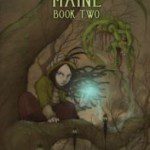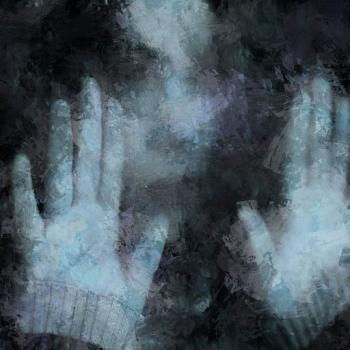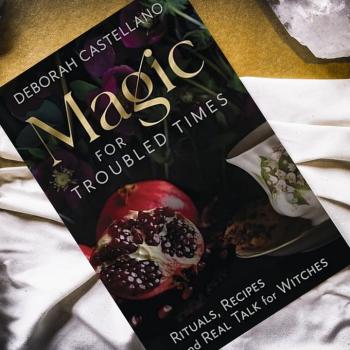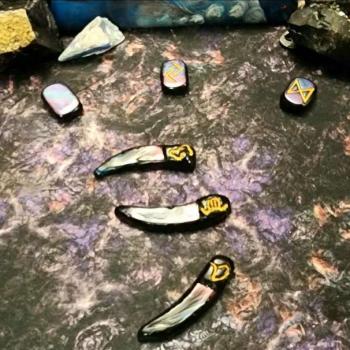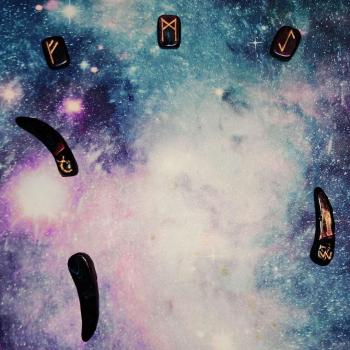 The Best of the Equinox – Vol 1: Enochian Magick is the record of Aleister Crowley’s experience making contact with angels using the methods and information of Dr. John Dee. The volume is composed of two separate books: Liber LXXXIV and Liber XXX AERVM, better known as The Vision and the Voice. The first book, Liber LXXXIV, is broken into two parts. Part One is an overly-complex description of the method by which the names of the angels were obtained and a list of the names themselves. Crowley’s tortured writing style and the inclusion of the transliterated Enochian language reduce much of this section to near-nonsensicality. One thing that Crowley does make clear is that Dee represented the 4th dimensional world of the angels as a square surrounded by 30 concentric circles or aethyrs, which Crowley will explore in great detail in the The Vision and the Voice.
The Best of the Equinox – Vol 1: Enochian Magick is the record of Aleister Crowley’s experience making contact with angels using the methods and information of Dr. John Dee. The volume is composed of two separate books: Liber LXXXIV and Liber XXX AERVM, better known as The Vision and the Voice. The first book, Liber LXXXIV, is broken into two parts. Part One is an overly-complex description of the method by which the names of the angels were obtained and a list of the names themselves. Crowley’s tortured writing style and the inclusion of the transliterated Enochian language reduce much of this section to near-nonsensicality. One thing that Crowley does make clear is that Dee represented the 4th dimensional world of the angels as a square surrounded by 30 concentric circles or aethyrs, which Crowley will explore in great detail in the The Vision and the Voice.
Part Two of Liber LXXXIV is titled “The 48 Calls or Keys”, and includes 19 calls, or maybe 20, since the 18th key proclaims: “These first 18 calls are in reality 19; that is 19 in the Celestial Orders; but with us the first table hath no call, and can have no call, seeing that it is of the Godhead. Thus, then, with us hath it the number of 0, though with them that of I…” The final key is titled “The Call or Key of the Thirty Aethyrs,” and this one key is actually 30 keys to be used in combination of the name of the aethyr that you’d like to explore. Part Two also introduces us to the style of language that Crowley uses throughout The Vision and the Voice: “I reign over ye, saith the God of Justice, in power exalted above the Firmament of Wrath…who measureth your Garments in the midst of my hands.” This awkwardly ornate style lends the Keys and the entirety of The Vision and the Voice an air of artificial antiquity and makes reading them incredibly tiring.
The second book in the volume, The Vision and the Voice is a collection of Crowley’s explorations of the 30 aethyrs. The power of the visions is undeniable, but their presentation is lamentable. Crowley is at best a highly uneven writer, at worst nearly unintelligible. The majority of the volume is written in the extemporaneous style of received prophecy, reminiscent of John’s biblical Revelation. While there are times when this style lends the volume an arresting immediacy, more often it lapses into the solipsistic ramblings of a blitzed-out stoner, whose profound experience can’t be properly communicated just with words, man: “I lie prostrate upon the ground before this mystery. Its splendour is impossible to describe. I can only say that its splendour is so great that my heart stops with the terror and the wonder and the rapture of it. I am almost mad. A million insane images chase each other through my brain…” Crowley’s experiences are noble, terrible, terrifying, and inspired in turns, but the intensely dramatic nature of each experience becomes exhausting to the reader, like a movie made up only of climactic explosions.
The visions themselves are intricately detailed, right down to the colors of sequins on the outfits. It’s clear that much of Crowley’s personal symbolism was solidified in this volume, some of it appearing almost unchanged in the Thoth Tarot that he created in tandem with Lady Frieda Harris nearly 40 years after The Vision and the Voice. For those already familiar with Crowleyana, this blast of syncretic religious and spiritual imagery may not be as intimidating as it will be for the first time reader, but even a familiar reader might find the onslaught of prophetic vision overwhelming.
Taken as a whole, the narrative of the 30 visions encompass a great arc, thickly veiled in the biblical language of received prophecy. While the aethyrs do reference one another, they don’t hand the prophet on to the next angel in the way that, say, Scrooge’s ghosts do in A Christmas Carol. There is a sense that it’s all related, but the labyrinthine language, deeply encoded religious symbolism, and intentional misdirection of Crowley’s own personal religious system (specifically the Formula of the Cup of Babalon, which pervades this volume), make it incredibly difficult to determine the direction or meaning of any of the aethyrs individually, or the significance of them as a whole, leaving me deeply unsatisfied for most of the book.
Thankfully, at the very end of The Vision and the Voice Crowley includes a short list titled “A Comment Upon the Nature of the Aethyrs” that clearly and concisely breaks down the action and significance of each vision singly and as a whole. In this new context, the 30 aethyrs are transformed from a series of incomprehensible visions into a dramatic initiation rite of into the transformational spiritual revolution that is the foundation of Crowley’s spiritual writing. The way that Crowley interweaves his personal religious symbols into a narrative populated by angels, whose lineage dates back to the biblical patriarch Enoch, is a reflection of where Crowley saw himself in the evolution of the Abrahamic faiths: not as a blasphemer, but as the next voice in the wilderness, leading the flock out of the dead end that the Abrahamic faiths offered and into the new age. Or in Crowley’s terms, out of the Aeon of Osiris and into the Aeon of Horus.
It is strangely ironic, then, that Crowley chose the language and mode of the very group he was critiquing to lead the world into its new aeon. It was this deeply flawed choice that left Crowley’s powerful, if Byzantine, work to languish in relative obscurity while the less spiritual but more accessible Carl Jung and Joseph Campbell went on to deeply influence the direction of personal spirituality in the new age. Though they’re clearly contemporaries, Crowley’s work and impact on contemporary western culture is hindered by its complication, secrecy and symbolism, and The Vision and the Voice is perfectly emblematic of that: a thorny bramble of pseudo-biblical prophecy that ultimately fails at the goal clearly stated in the 6th aethyr: “And thou shalt not seek to better this my instruction; but thou shalt interpret it, and make it easy, for them that seek understanding.” In being unable, or perhaps unwilling, to give the world a straightforward prophecy for a new age, or perhaps simply in couching his work in the language of prophecy itself, Crowley’s powerful vision of self-empowerment remains mostly ignored by a generation of people eager for spiritual alternatives to the religion they were raised with, and for good reason: his text is largely unreadable and hardly worth revisiting for any but the most dedicated student of magick.
 Adam Blodgett is an artist, writer, and designer with a deep interest in magick and its everyday applications. He lives in Olympia, Washington, where he runs Pixelsmith Design and works feverishly to finish his super-cute tarot deck, the Chibi Tarot.
Adam Blodgett is an artist, writer, and designer with a deep interest in magick and its everyday applications. He lives in Olympia, Washington, where he runs Pixelsmith Design and works feverishly to finish his super-cute tarot deck, the Chibi Tarot.



